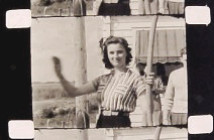H2O
Ralph Steiner, 13 min., 35mm, 1929
Preserved by the Museum of Modern Art
Added to National Film Registry: 2005
Essay by Charles Tepperman
Ralph Steiner is best known in film history as a documentary filmmaker; an early member of the New York Film and Photo League, Steiner later served as a cameraman for Pare Lorenz’s film The Plow that Broke the Plains (1936), and co-directed The City (with Willard van Dyke, 1939). But before this, Steiner was a still photographer, who worked in both commercial and artistic settings, and a participant in the “first American film avant-garde” (Horak). As an artistic and commercial photographer, Steiner produced starkly realistic and dramatically framed images of everyday objects, such as typewriters and cars, which defamiliarized them through manipulations of scale or unusual context. This was part of a general move from pictorialism – photography made painterly – to straight photography’s more documentary, machine-like vision. Like other American artists experimenting with film and photography during this period, Steiner found himself positioned in a triangulation of commercial advertising work, high art experiments, and amateur contexts (Horak). Steiner was especially influenced by the photographer and filmmaker Paul Strand who (with Charles Sheeler) produced one of the first American avant-garde films, Manhatta in 1921. In the late 1920s, Steiner began experimenting with motion pictures; H2O was his first completed film.
H2O’s dramatic combination of straight photography and abstracting composition brought Steiner’s film to the attention of Photoplay magazine, and it subsequently won first prize in the non-dramatic category of the magazine’s 1929 amateur film competition. “H20 is a study of water and its moods,” reported the magazine’s amateur film editor:
Mr. Steiner used a six and twelve inch lens… to get his water reflections enlarged and to get pure abstract patterns of shadows on water surfaces. “No tricks of any kind were used,” said Mr. Steiner, “as I was interested in seeing how much material could be gotten by trying to see water in a new way, rather than by doing things to it with the camera.” (“Amateur Movies”)
Steiner’s remarks on the film set his approach to cinematics apart from the anti-realist style of American experimental filming exemplified by Watson and Webber’s Fall of the House of Usher (1928). In contrast to their expressionism-inspired approach, Steiner emphasizes that he wanted to use the camera “to see water in a new way” but without resorting to optical manipulations, such as prisms or artificial animations. The resulting film is a fascinating meditation on light reflections and fluid motion, as well as the line between realism and abstraction.
H20 organizes its imagery through an assemblage of short shots, rarely lasting longer than a second or two, edited together according to graphic contrasts and complimentary visual qualities. Steiner asked Aaron Copland to help him with the editing of the film, in the belief that the composer would “know about unity and progression, and that these had to be important to film editing.” (Steiner). At first, the film primarily shows water in a specific context: coming down in drops, in a waterfall, or gushing out of a pipe or hole. In the middle section of the film, the images appear more concerned with the reflective properties of moving pools of water; but we almost always see the edges of these pools, or some foliage or floating matter that anchor these images in terms of shot scale and angle. In its third section, the film moves increasingly towards abstraction through close-up, high contrast images of light flickering and reflecting on water. Part of the film’s playfulness is the game of ‘figure and ground’ that it invites us to join in, offering us both shimmering reflections as well as drops or dust on the water’s surface, forcing us to constantly re-orient our viewing of the water itself. In the film’s last moments these images become increasingly abstract, and the water appears to be reduced to waving lines, like animated drawings. Even though we’ve been tutored by the film to see these images as rooted in the world, its final moments strain this belief as they show images that appear sped up or slowed down, and shot scale becomes nearly impossible to determine. Just as its title suggests a more molecular understanding of the materials and properties which make up something as commonplace as “water,” so this film offers a consideration of the materials and properties that make up moving pictures – light, time and motion – at its most essential level.
H2O was shot on 35mm film and was partially funded by a grant from the Elmhurst Foundation. These qualities make it unusual for an amateur film of the period, which was more like to be filmed on 16mm with no financial support. But in the late 1920s and early 30s any film produced outside the commercial industry might have been described as amateur. Photoplay magazine, the most commercially-oriented and popular of movie magazines, acclaimed H20 in hopes that the recognition would “stimulate amateurs to a realization of the wide range of filming opportunities left untouched” by Hollywood (“Here are the Winners”). H20 was discussed in amateur movie magazines and screened in amateur movie clubs, so it might have presented such a model for amateurs to approach abstract filmmaking. Steiner made two additional experimental films, Surf and Seaweed (1930) and Mechanical Principles (1930), before shifting decisively to documentary film work in the early 1930s.
Adapted from Amateur Cinema: The Rise of North American Moviemaking: 1923-1960 (Berkeley: University of California Press, 2015).
Works Cited
“Amateur Movies,” Photoplay, Aug, 1929, 71.
Horak, Jan-Christopher, ed. Lovers of the Cinema: The First American Avant-Garde, 1919-1945. Madison: University of Wisconsin Press, 1995.
“Here are the Winners,” Movie Makers, Nov. 1929, 734
Steiner, Ralph. A Point of View. Middletown: Wesleyan University Press, 1978.
Charles Tepperman is a professor of film history and media studies at the University of Calgary.

